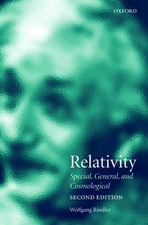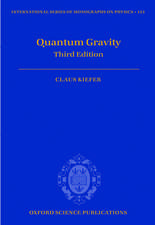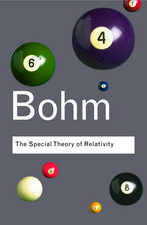General Relativity
Autor Robert M. Walden Limba Engleză Paperback – 15 iun 1984
"Wald's book is clearly the first textbook on general relativity with a totally modern point of view; and it succeeds very well where others are only partially successful. The book includes full discussions of many problems of current interest which are not treated in any extant book, and all these matters are considered with perception and understanding."—S. Chandrasekhar
"A tour de force: lucid, straightforward, mathematically rigorous, exacting in the analysis of the theory in its physical aspect."—L. P. Hughston, Times Higher Education Supplement
"Truly excellent. . . . A sophisticated text of manageable size that will probably be read by every student of relativity, astrophysics, and field theory for years to come."—James W. York, Physics Today
"A tour de force: lucid, straightforward, mathematically rigorous, exacting in the analysis of the theory in its physical aspect."—L. P. Hughston, Times Higher Education Supplement
"Truly excellent. . . . A sophisticated text of manageable size that will probably be read by every student of relativity, astrophysics, and field theory for years to come."—James W. York, Physics Today
Preț: 426.22 lei
Nou
Puncte Express: 639
Preț estimativ în valută:
81.56€ • 87.21$ • 68.00£
81.56€ • 87.21$ • 68.00£
Carte disponibilă
Livrare economică 24-29 martie
Livrare express 13-19 martie pentru 49.44 lei
Preluare comenzi: 021 569.72.76
Specificații
ISBN-13: 9780226870335
ISBN-10: 0226870332
Pagini: 506
Ilustrații: 72 illustrations
Dimensiuni: 165 x 235 x 33 mm
Greutate: 0.84 kg
Editura: University of Chicago Press
Colecția University of Chicago Press
Locul publicării:United States
ISBN-10: 0226870332
Pagini: 506
Ilustrații: 72 illustrations
Dimensiuni: 165 x 235 x 33 mm
Greutate: 0.84 kg
Editura: University of Chicago Press
Colecția University of Chicago Press
Locul publicării:United States
Public țintă
Academic/professional/technical: Undergraduate. Academic/professional/technical: Postgraduate. Academic/professional/technical: Research and professionalNotă biografică
Robert M. Wald is professor in the Department of Physics and the Enrico Fermi Institute at the University of Chicago. He is the author of Space, Time, and Gravity: The Theory of the Big Bang and Black Holes, also published by the University of Chicago Press.
Cuprins
Preface
Notation and Conventions
PART I. FUNDAMENTALS
1. Introduction
1.1 Introduction
1.2 Space and Time in Prerelativity Physics and in Special Relativity
1.3 The Spacetime Metric
1.4 General Relativity
2. Manifolds and Tensor Fields
2.1 Manifolds
2.2 Vectors
2.3 Tensors; the Metric Tensor
2.4 The Abstract Index Notation
3. Curvature
3.1 Derivative Operators and Parallel Transport
3.2 Curvature
3.3 Geodesics
3.4 Methods for Computing Curvature
4. Einstein's Equation
4.1 The Geometry of Space in Prerelativity Physics; General and Special Covariance
4.2 Special Relativity
4.3 General Relativity
4.4 Linearized Gravity: The Newtonian Limit and Gravitational Radiation
5. Homogeneous, Isotropic Cosmology
5.1 Homogeneity and Isotrophy
5.2 Dynamics of a Homogeneous, Isotropic Universe
5.3 The Cosmological Redshift; Horizons
5.4 The Evolution of Our Universe
6. The Schwartzschild Solution
6.1 Derivation of the Schwartzschild Solution
6.2 Interior Solutions
6.3 Geodesics of Schwartzschild: Gravitation Redshift, Perihelion Precession, Bending of Light, and Time Delay
6.4 The Kruskal Extension
PART II. ADVANCED TOPICS
7. Methods for Solving Einstein's Equation
7.1 Stationary, Axisymmetric Solutions
7.2 Spatially Homogeneous Cosmologies
7.3 Algebraically Special Solutions
7.4 Methods for Generating Solutions
7.5 Perturbations
8. Casual Structure
8.1 Futures and Pasts: Basic Definitions and Results
8.2 Causality Conditions
8.3 Domains of Dependence; Global Hyperbolicity
9. Singularities
9.1 What is a Singularity?
9.2 Timelike and Null Geodesic Congruences
9.3 Conjugate Points
9.4 Existence of Maximum Length Curves
9.5 Singularity Theorems
10. The Initial Value Formulation
10.1 Initial Value Formulation for Particles and Fields
10.2 Initial Value Formulation of General Relativity
11. Asymptotic Flatness
11.1 Conformal Infinity
11.2 Energy
12. Black Holes
12.1 Black Holes and the Cosmic Censor Conjecture
12.2 General Properties of Black Holes
12.3 The Charged Kerr Black Holes
12.4 Energy Extraction from Black Holes
12.5 Black Holes and Thermodynamics
13. Spinors
13.1 Spinors in Minkowski Spacetime
13.2 Spinors in Curved Spacetime
14. Quantum Effects in Strong Gravitational Fields
14.1 Quantum Gravity
14.2 Quantum Fields in Curved Spacetime
14.3 Particle Creation near Black Holes
14.4 Black Hold Thermodynamics
APPENDICES
A. Topological Spaces
B. Differential Forms, Integration, and Frobenius's Theorem
B.1 Differential Forms
B.2 Integration
B.3 Frobenius's Theorem
C. Maps of Manifolds, Lie Derivatives, and Killing Fields
C.1 Maps of Manifolds
C.2 Lie Derivatives
C.3 Killing Vector Fields
D. Conformal Transformations
E. Lagrangian and Hamiltonian Formulations of Einstein's Equation
E.1 Lagrangian Formulation
E.2 Hamiltonian Formulation
F. Units and Dimensions
References
Index
Notation and Conventions
PART I. FUNDAMENTALS
1. Introduction
1.1 Introduction
1.2 Space and Time in Prerelativity Physics and in Special Relativity
1.3 The Spacetime Metric
1.4 General Relativity
2. Manifolds and Tensor Fields
2.1 Manifolds
2.2 Vectors
2.3 Tensors; the Metric Tensor
2.4 The Abstract Index Notation
3. Curvature
3.1 Derivative Operators and Parallel Transport
3.2 Curvature
3.3 Geodesics
3.4 Methods for Computing Curvature
4. Einstein's Equation
4.1 The Geometry of Space in Prerelativity Physics; General and Special Covariance
4.2 Special Relativity
4.3 General Relativity
4.4 Linearized Gravity: The Newtonian Limit and Gravitational Radiation
5. Homogeneous, Isotropic Cosmology
5.1 Homogeneity and Isotrophy
5.2 Dynamics of a Homogeneous, Isotropic Universe
5.3 The Cosmological Redshift; Horizons
5.4 The Evolution of Our Universe
6. The Schwartzschild Solution
6.1 Derivation of the Schwartzschild Solution
6.2 Interior Solutions
6.3 Geodesics of Schwartzschild: Gravitation Redshift, Perihelion Precession, Bending of Light, and Time Delay
6.4 The Kruskal Extension
PART II. ADVANCED TOPICS
7. Methods for Solving Einstein's Equation
7.1 Stationary, Axisymmetric Solutions
7.2 Spatially Homogeneous Cosmologies
7.3 Algebraically Special Solutions
7.4 Methods for Generating Solutions
7.5 Perturbations
8. Casual Structure
8.1 Futures and Pasts: Basic Definitions and Results
8.2 Causality Conditions
8.3 Domains of Dependence; Global Hyperbolicity
9. Singularities
9.1 What is a Singularity?
9.2 Timelike and Null Geodesic Congruences
9.3 Conjugate Points
9.4 Existence of Maximum Length Curves
9.5 Singularity Theorems
10. The Initial Value Formulation
10.1 Initial Value Formulation for Particles and Fields
10.2 Initial Value Formulation of General Relativity
11. Asymptotic Flatness
11.1 Conformal Infinity
11.2 Energy
12. Black Holes
12.1 Black Holes and the Cosmic Censor Conjecture
12.2 General Properties of Black Holes
12.3 The Charged Kerr Black Holes
12.4 Energy Extraction from Black Holes
12.5 Black Holes and Thermodynamics
13. Spinors
13.1 Spinors in Minkowski Spacetime
13.2 Spinors in Curved Spacetime
14. Quantum Effects in Strong Gravitational Fields
14.1 Quantum Gravity
14.2 Quantum Fields in Curved Spacetime
14.3 Particle Creation near Black Holes
14.4 Black Hold Thermodynamics
APPENDICES
A. Topological Spaces
B. Differential Forms, Integration, and Frobenius's Theorem
B.1 Differential Forms
B.2 Integration
B.3 Frobenius's Theorem
C. Maps of Manifolds, Lie Derivatives, and Killing Fields
C.1 Maps of Manifolds
C.2 Lie Derivatives
C.3 Killing Vector Fields
D. Conformal Transformations
E. Lagrangian and Hamiltonian Formulations of Einstein's Equation
E.1 Lagrangian Formulation
E.2 Hamiltonian Formulation
F. Units and Dimensions
References
Index
















